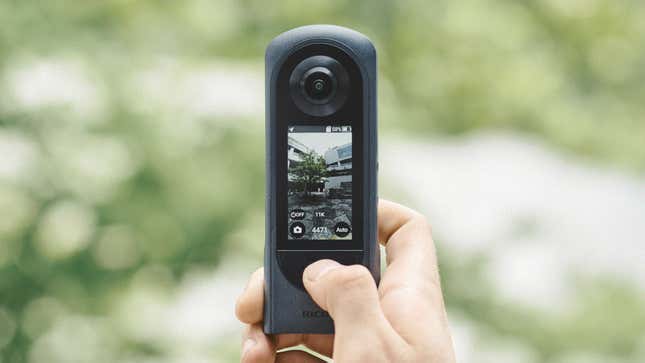
If you want to capture 3D photos or footage on a budget, Ricoh’s Theta line continues to be a relatively affordable alternative to multi-camera rigs. It’s a much easier solution now, too: The new Theta X is the company’s first 360-degree camera with a touchscreen and other upgrades that make it easier to use as a standalone camera.
There are still plenty of mobile apps that leverage a smartphone or tablet’s camera and motion sensors to capture 360-degree imagery, but it’s a painstaking process requiring users to constantly reposition their device as if trapped inside a large sphere. A dedicated 360-degree camera makes it easier to snap panoramic images with a single button press, and they allow 360-degree videos to be captured just as easily. These devices might not be as popular as they once were, but they’re still very useful for creating content for VR and an important tool when it comes to blending visual effects with live-action footage.

Ricoh’s Theta devices use a pair of back-to-back cameras with 180-degree fisheye lenses to capture everything around the device in a single snap, but to help keep the price and size down, they rely on a connection to a mobile app for configuring settings and providing the photographer with a live preview for framing shots. The new Theta X is Ricoh’s first camera to feature a 2.25-inch touchscreen display, which is not only useful for framing shots sans a smartphone, it also makes it easier to configure settings, connect to wireless networks, and perform firmware updates on its own.
The Theta X also runs an Android-based OS, which will allow third-parties to develop custom plugins to expand the camera’s capabilities—a feature that will also benefit from the built-in touchscreen, allowing these plugins to be installed directly from the device. To further improve the Theta X’s functionality as a standalone camera, Ricoh has also introduced a swappable rechargeable battery, and the ability to capture content to a microSD card instead of just the device’s 46GB of internal memory.
Image and video quality appear to be a step up from the Theta Z1. The Theta X captures 11K images for “high-resolution bright-light indoor photography” or at 5.5K “to capture images easily and efficiently in other scenarios.” Video can also be captured at up to 5.7K resolutions (5760 × 2880) at 30 frames per second, or up to 60 frames per second when dropping down to 4K (3840 × 1920).
Other features include more streamlined Bluetooth connectivity without the need for PIN codes, built-in GPS and support for A-GPS, and a USB-C connector for file transfers and powering the camera while it’s in use. Available starting in March, the $800 Theta X will actually be slightly cheaper than the $1,050 Theta Z1, but that’s because it will actually lack some pro features like the ability to shoot in RAW mode or record spatial audio alongside video.